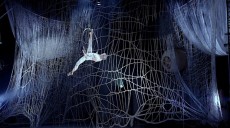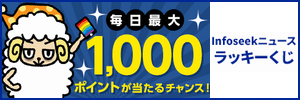Interview with Una Lorenzen + Heather Millard about 『YARN』
NeoL / 2017年12月1日 18時31分
YARNとは、織物や編み物に用いる糸。そして面白い冒険談をたっぷり話すという意味の言葉。そのタイトル通り、今作は編み物にまつわる素晴らしく刺激的なアートを追ったドキュメンタリーだ。家庭内で行う工芸としてアートとはなかなか認めらない編み物だが、この作品に登場する4組は驚くほどに自由でしなやか、時にパンクな発想とそれを形にする確かな技術とで私たちの常識や想像を軽く覆す作品を作り出す。そして、それら明るい色とりどりの編み物とアーティストを追ううちに、私たちは世界が抱えるジェンダー、政治、環境など様々な問題についても目にし、共に考えることになるのだ。この傑作について、ウナ・ローレンツェ監督と共同監督兼プロデューサーのヘザー・ミラードにインタビューを試みた。
ーYARNを題材に選んだ理由を教えてください。
Heather Millard「最初にインスピレーションを得たのは、映画祭で脚本家でありエグゼクティエグゼクティヴ・プロデューサーのKrishan Aroraと、次はどんな”伝統的/家庭的"な活動がトレンドになるかという話をしていたときです。テレビ番組の『the Great British Bake Off』の影響でパンを焼くことへの興味が幅広い層で拡大していることについて話していて、『じゃあ、編み物はどうだろう?』と考えました。この思い付きがどんどん膨らんで、編み物について、そして後にかぎ針編みについても調べ始めました。そのうちに、編み糸で作られているとんでもなく素晴らしい芸術作品をたくさん発見したというわけです」
ーーあの4組のアーティストを選んだ理由をお願いいたします。
Heather Millard「『YARN』に良さそうな人を探して世界中を巡って、男性も女性も多くの人に会いました。男性のニッターを出さなかったのは意図的ではなく、偶然そうなったのです。今回出てくれたアーティストたちは、一人ひとりがお互いの言っていることを支えたり、時には対立するような強いメッセージや議題を持っていて、彼らが登場人物として一番興味深い人材だと思いました。しかし、彼ら以外にも世界中に編み糸を使っているおもしろい男性、女性がまだまだ沢山いるので、続編を作ることだって全くないとは言い切れないくらいです」
Una Lorenzen「私たち映画を作る側の人間がメッセージをコントロールするのではなく、編み物の世界のそれぞれ違う場所に位置する人たちが登場することで、彼らやその活動自体が声となり、そこにある問題の概要を詩的に提示するという形を考えていました。とはいえ、本作のように幅広い題目がある場合、”赤い糸”は必要不可欠。脚本家とプロデューサーは、最近トレンドとなっている手作業(大抵はかぎ針編み)に焦点を置いてアーティストを探していました。
編み糸へのノスタルジーと驚きを呼び起こすことに焦点を置き、巨大で立体的なものからウールの靴下までを紹介することで、登場人物と彼女たちの歩みが描き出す多くの議題にスムースに感情移入させたのです。あたたかみのあるアニメーションとバーバラ・キングソルヴァの散文とオリジナルの音楽を使ったのも、そのためです」
ーー2年かけて制作したそうですが、どれくらいの撮れ高がありましたか。その中からあの内容に絞るためのポイントをどこにおきましたか。
Heather Millard「実は、制作には2年以上かかっているんです。2012年にコンセプトを考えはじめて、2016年に完成したので本当に長い道のりでした。『YARN』の撮影のために、アイスランド、アメリカ、キューバ、ハワイ、カナダ、ドイツ、オランダ、スペイン、イギリス、イタリア、ノルウェー、スウェーデン、デンマークの12国を巡り、最終的には70時間に及ぶフッテージがあり、エディターのThorunn Hafstadとかなりの時間をかけて編集を行いました。やむなくカットした素晴らしい映像もたくさんあるので、特典映像のようなものが作れたらいいなと思っています。編み糸のカラフルでポジティブな要素を見せる映画にしたいという明確な意図があったけれども、同時にアートとクラフトの関係など議論になるような題目も含めたい。それが編集のポイントでした」
ーー映画内には編み物を通じ、様々な国の現状、アートや表現、フェミニズム、環境、政治、教育についてなどの問題が描かれています。当初からこのような問題も同時に描く予定だったのか、作るうちに付随する問題として出ていたのか、教えてください。
Heather Millard「当初は、編み糸で作られた世界中の様々の素晴らしい作品へと導くためのポジティブな映画を作り出す計画でした。けれども、Olecの撮影の初日も、そそして登場人物たちと撮影を行ったどの日も、編み物に留まらない強いメッセージを各々が持っていることを感じて、私たちはそれに魅了されました。そのメッセージがなくしては、『YARN』は作ることができなかったのです」
ーーアーティストの登場の順番にも意味があるように思えます。最初にアーティストでポリティカルなTinaを持って来たことで単なるクラフトの映画ではないことがしっかりと伝わりました。そこからファッションとも繋がる華やかなOlek、フィジカルなCircus Cirkor、アートから繋がりという変遷を体現したToshiko Horiuchiが最後に登場します。この順番に関してどういう風にコンセプトだてを行ったのでしょうか。
Heather Millard「もちろん意味があります。冒頭は羊という編み糸の根源から始めたくて、そこからいろんな題材を巡り、始まりと同じように羊の毛で映画を閉じたかった。他の登場人物の順序は詩的なもので、物語の流れがいいように、そして、常に面白味を与えられるように配置しました」
ーーOlekと同様に監督もバックボーン/ルーツに戻ってこの映画を制作していますよね。アーティストにとってルーツに立ち返ることの意味を教えてください。また、あなたにとってそれはどんな発見をもたらしましたか。
Una Lorenzen「母がレイキャビクの美術学校のテキスタイル科長だったので、幼少時代からそういうものと親しんできました。北欧諸国にはいたるところに羊やウールがあるので、それも慣れ親しんだものだったのです。今やテキスタイルアートの認知度は上がり、それは私たちの認識を変えるくらいのものになっています。だから、編み糸を使っている様々なアーティストを見つけて、追いかけ、映画のメッセージを伝える”声”になってもらいました。ノスタルジーに加えて、その可能性や伸びしろをしっかりと示したかったのです」
ーーインタビューで語られる言葉の一句一句が経験に基づいた含蓄の深いものでした。どのようなインタビューを行うことであのような言葉を引き出したのでしょうか。
Heather Millard「アーティストに本当に恵まれていたんです。大抵は彼女たちがわりと自由に自分たちの議題や作品について語ってくれました。スタンダードなインタビューも行ったけれども、彼らが作業中に打ち解けたインタビューも行って、両方のインタビューを含めました」
ーー映画の中にはバーバラ・キングソルヴァの短編小説の言葉が出て来ますが、あの小説をピックアップしたのはなぜ?
Heather Millard「脚本家でエグゼクティブ・プロデューサーであるKrishan Aroraがバーバラ・キングソルヴァの『始まるところ』を見つけたんです。読み終えて彼女の言葉の芳醇さとあたたかみに惹かれたし、映画を通して彼女の言葉に本当に共感することができたのでバーバラと連絡をとってみたら、驚くことに彼女は私たちの映画に参加することに興味があると答えてくれたのです。彼女の家の近くのスタジオ付近で朗読をレコーディングして、特定のセリフを様々な場面に埋めてみて、順序を決めていきました」
ーー監督は元々アニメーションを制作していましたが、今回実写に移行したきっかけは? 共通点と違いを教えてください。
Una Lorenzen「最初は『YARN』のアニメーターとして出発したのですが、プロデュサー兼共同監督のヘザーに監督の仕事を任せてもらって、やってみようと思ったのです。アニメーションと実写の映画とは全く違うので難しかったけれども、新しい知識をたくさん吸収することができました」
ーーとても彩りの鮮やかな映画です。アニメーションをてがけるあなたにとっても色は大切な要素だと思います。あなたにとって色が持つ意味は?あの色で世界に何をもたらそうと思ったのでしょう。
Una Lorenzen「明るくて気分を高めてくれるような映画にしたかったので、全体的に色鮮やかな映画にしました。この映画に使うアニメーションを作っていた際は、全体をうまくまとめるために、映像の中に既ににあったものを使いました。強い人工的な色もあれば、アイスランドの羊のアットホームでナチュラルな色もあります。そして、Cirkus Cirkörのパフォーマンスの時のように、真っ白なものもある。アーティストによって使われているこれらの強い色は、注目を集めたり、メッセージを強調したり、純粋に子どもたちを喜ばせるなど彼らの活動に沿って選ばれています」
ーー編み物が身近すぎてアートとして捉えられないという問題はとても興味深かったです。それにひもづくフェミニズムの問題もとても的確な指摘でした。女性のアーティストとして、女性監督として、同じような問題を体験したことがありますか。
Una Lorenzen「映像作家をやっていて、ただ単に女性だと理由だけで反感を抱かれたことは確実にあります。けれども事態は良い方向に変わっていっていると実感しています。どの分野でも、変化の波は存在するし、間違いなく物事は前に進んでいます」
---編み物は引き継がれていく伝統のものでもありながら、この映画ではリベラルで非常にアーティスティックな側面が強く打ち出されています。同じように見過ごされているアートとして注目しているものがありますか。
Heather Millard「ええ、もちろん。編み物だけでなく、刺繍、クロスステッチ、裁縫などのハンドクラフトも広がりを見せています。イギリズで大ヒットしたテレビ番組『Great British Bake Off』でも見られるように、パンを焼くことも全て芸術として捉えられるようになってきました。ハンドクラフトや家政学の分野にはそうしたものがたくさんあります」
ーー世界はデジタル化が進む一方で、YARNのようなフィジカルな表現へも注目をし始めている気がします。手作り/フィジカルであるものとは人間にとってどうして重視されるのか。どのような感情や記憶を呼び起こすのでしょう。
Una Lorenzen「そう、間違いなくハンドメイドも身体的表現もどんどん貴重なものになっていくと思います。それは人間とマシーンの自然な成り行きですよね。手作りのものは、私たちをあたたかく、人間らしい気持ちにしてくれる。だから、どんな時代になってもハンドメイドのものにより魅力を感じるんだと思います」
interview & edit Ryoko Kuwahara
『YARN 人生を彩る糸』
12月2日、渋谷シアター・イメージフォーラム他、全国順次公開
© Compass Films Production 2016
提供・配給:ミッドシップ+ kinologue
監督:ウナ・ローレンツェン(長編デビュー作/アニメーター)
出演:オレク (かぎ針編みアーティスト)、サーカス・シルクール (コンテンポラリーサーカス)、ティナ(ヤーン・グラフィティ・アーティスト)、堀内紀子(テキスタイル・アーティスト)
ナレーション:バーバラ・キングソルヴァー(米ベストセラー作家) 「始まるところ」より
2016年/アイスランド・ポーランド/英語・アイスランド語/ドキュメンタリー/76分 SXSW2016正式出品
後援:駐日アイスランド大使館 提供・配給:ミッドシップ+ kinologue © Compass Films Production 2016
www.yarn-movie.com Facebook: /yarn.movie twitter: @yarn_movie Instagram:yarn.movie
ーーWhy did you choose YARN as the theme?
Heather Millard : We were first inspired whilst at a film festival when writer/executive producer Krishan Arora and I were talking about what could be the next ‘traditional’/’home’ activity to become trendy. We talked about how the Great British Bake Off had helped to create a widespread interest in baking and then we thought, “what about knitting?”. The idea really snowballed from there as we began researching knitting and later crochet, too, and we found so many incredible works of art and people that are creating interesting things with yarn.
ーーWhy did you choose those four group of artists out of the large number of artists you encountered in each location?
Heather Millard : Whilst we were researching potential characters for the film YARN, we came across many possible characters – both males and females – from across the world. At first it wasn’t a deliberate effort to exclude male knitters/crocheters from the film but after we had found the contributors that are in the film, each with their own strong message or agenda that would all compliment and at times conflict with one another we felt they were the most interesting contributors to include in our film. That’s not to say we couldn’t make a sequel as there really are many other interesting men and women using yarn throughout the world.
Una Lorenzen : The idea was to make a poetic overview of the subject and so the film includes people from very different sections of the yarn world. They are the voice of the film, rather than us filmmakers controlling the overall message. However, with a vast subject like this, a red thread is a must and when our writer and producer were looking for artists to highlight they were focusing on people who work mostly by hand (and as it turns out mostly crochet), a technique that is very trendy these days.
Creating a film focusing on the nostalgic and sensational feel of yarn, taking us anywhere between giant yarn sculptures and wool socks, tapping into a vast subject through a poetic overview of our characters and their journey. We used the textured animations, Barbara Kingsolver’s prose and original music to emphasize the nostalgic and sensational mood.
ーーI heard you spent 2 years creating it, but how much content that was actually used in the film were you able to get? What were things you looked for to narrow it down that content?
Heather Millard : We actually spent more than 2 years creating the film. The concept was initiated in 2012 and then we completed the film in 2016, so it was quite the journey. We travelled around Iceland, to the US, Cuba, Hawaii, Canada, Germany, Netherlands, Spain, UK, Italy, Norway, Sweden, Denmark - as you can see to over 12 different countries filming for YARN and had around 70 hours of footage by the end of it, we spent a considerable time in the edit with our wonderful editor Thorunn Hafstad where we laid many scenes on the timeline and changed the order and the scenes numerous times, until we had a cut that we were happy with. There is so much wonderful footage that we have with all of our contributors and more that just couldn’t make it into the film, but we would love to somehow make more bonus material to show some of this material off too at a later stage. Once we had defined our narrative we were able to eliminate scenes more easily, we wanted the film to be a colorful and positive explosion of yarn, but at the same time touch upon some of the controversial topics that it does as well as the conflicts within the art and the craft world and these subject matters really helped to clarify the scenes that we would then include in the finished film.
ーーI think that there are a lot of problems conveyed through YARN such as, the country's current situation, art and expression, feminism, environmental issues, political issues, and educational issues. Were these problems you had planned to convey from the start? Or did these problems come up during the process?
Heather Millard : Initially we planned to produce a positive film exploring all of the wonderful pieces of yarn work that are being produced around the world. However, on the very first day of filming with Olek and then on almost every filming day with all of our contributors we learnt that they all had a message to convey and that there was so much more to the yarn work that we were planning to feature in the film than the colorful positive decoration and that’s what really captured our attention. We could no longer make a film on YARN without all of the deep messages that our artists had to convey in their work.
ーーI feel that there’s meaning in the order the artists appear. By bringing Tina, who is an artist with political ways of thinking, it successfully conveyed that this film is not just an art. Then you brought in gorgeous Olek who connects to fashion, then Circus Cirkor who is physical, and lastly Toshiko Horiuchi who expressed the transition with her body that she wants to connect through art. What kind of concept was behind creating this order?
Heather Millard : Absolutely, we felt that the beginning of the film had to be where the yarn begins, on the sheep and to venture into the subject from there and then to end the film back at the beginning, where it all begins on the sheep. The positioning of the other contributors in the film was a poetic one, a way for the narrative to flow and for the contributors to be placed next to each other so that they compliment one another or conflict with one another to keep the flow interesting.
ーーMuch like Olek, you created this film by going back to your backbone/roots. What does it mean to go back to your roots as an artist? Also, what did you discover by doing so?
Una Lorenzen : I was raised with a mother who was the head of the textile department at an art school in Reykjavik, so I grew up around that stuff. I also grew up around a lot of sheep and wool, which we have a lot of in the Nordic countries. At the time, it seemed like more and people were becoming aware of the textile arts, and its ability to change us. So we decided to find a variety of artists working with yarn and follow them and allow them to be the voice of the film. We wanted to show the sensual and nostalgic aspects of yarn, but also the tension it can create.
ーーEvery single word in the interview implied something very deep that came from an experience. In order to have them open up like that and pull our words from them like that, what kind of interview was done?
Heather Millard : We were incredibly lucky with our contributors, for the most part they spoke quite freely with us about their agendas and artwork. We conducted standard interviews as well as informal interviews whilst they worked on their artwork - it really was a combination of both styles of interviewing that we included in the film.
ーーWords from the short story by Barbara Kingsolver are included in the film, but how come you picked up that?
Heather Millard : Our writer/executive producer Krishan Arora first came across the prose by Barbara Kingsolver ‘Where it Begins’. After reading it we were all very drawn to the richness of her words and the warmth we felt when reading them. We could relate so much to them through our film. As a result, we reached out to Barbara and to our surprise she responded with interest to take part in our film. We recorded her reading the prose in a studio near her home in the US and then we worked it into the edit, trying out the specific lines she read in several places before settling on the exact order.
ーーWhat made you convert an animation to making a film this time? What are the similarities?
Una Lorenzen : I assume you mean why I decided to do a live action film rather than animation which I usually do? Well, I started out as the animator for Yarn, then I was offered by Heather the producer and co-director to take on directing. I decided to give it a try. Animation is a completely different world than life action film making so therefore it was challenging but I learned a lot from it.
ーーI was really into the issue that the presence of YARN was too close that it was difficult to comprehend it as art. Which connected to feminism, and what was indicated about it was very accurate. As a female artist and female director, have you experienced something similar to that?
Una Lorenzen : I have definitely experienced a resistance as a filmmaker, simply because I am female. But I do feel things are changing for the better. We have waves of changes in all fields and things are definitely moving forward.
ーーAs YARN is a very legendary and is something that is being continued to be passed down, a liberal and very artistic side of it was strongly exposed in this film. Are there things that being remarked but are similarly being overseen as art?
Heather Millard : Absolutely, it spans wider than the YARN community into most areas of handicraft art such as embroidery, cross stitch, sewing and even into the world of home economics such as baking - as can be seen with the ‘Great British Bake Off’ television series which is a huge hit in the UK - it clearly shows how baking can too be considered art. There are many examples in the handicraft arena and home economics area.
ーーDespite the fact that everything in this world is becoming digital, it feels like the attention towards physical expression like YARN is growing as well. Will homemade things and physical things be considered seriously as a human being? What kind of emotions and memories can they evoke?
Una Lorenzen : I have no doubt that as we head for more digital world the handmade things and longing for physical expression will grow even stronger. It seems like a natural progress of man and machine. Handmade things make us more human and we will always lean towards that because it gives us a warm fuzzy feeling.
ーーIt’s a very colorful and bright film. Since you were work on animations, is the color an important element for you? What kind of meaning do colors have for you? What kind of world do you think those colors bring out?
Una Lorenzen : The overall tone of the film is indeed very colorful because we wanted the film to be bright and uplifting. When creating the animation I simply used the palette we already had going on in the film to tie it all together. We have the strong synthetic colors and we also have the natural colors from the sheep in Iceland which bring a warm home-y feel. Then we have the absence of color in the all-white performance of Circus Circör. The strong colors used by the artists are in a lot of cases chosen to capture attention and underline statements or simply to bring joy to young ones. We did have a beautiful sequence of the natural dying process of the Icelandic wool, but sadly that section did not make it in the film.
ーーYou’re currently in Canada, but how come Canada is your base? Can you tell me about the art scene in Canada?
Una Lorenzen : I moved to Montreal with my ex-partner 7 years ago and now have a family here. Montreal is a very vibrant city with a very strong film and performance art scene. The animation scene is also very significant here, partly due to all the great work of the National Film board of Canada which has its base here in the city.
ーーI heard you’re in the middle of making something new at the moment, but what is your next project going to be like?
Una Lorenzen : I'm focusing on animated films right now but nothing I can share at the moment.
Heather Millard : Absolutely, we’re always working on something new. At the moment we have a few projects in the pipeline, including a television series with Tinna (from YARN) called ‘In Stitches' as the presenter/host, taking us on a journey around the Nordic countries exploring handicrafts being used at home and in the art world. We are also working on another television series ‘Ormhildur the Brave’ which will be a children’s animated series, and another documentary film ‘Science of Play’ inspired by Toshiko from YARN and focusing on the importance of play for the development of children.
interview Ryoko Kuwahara
関連記事のまとめはこちら
http://www.neol.jp/art-2/
外部リンク
この記事に関連するニュース
-
「私たちを人間として扱ってほしい」やまぬ爆撃、家族との別れ…ガザ脱出の友人を探し記者がエジプトへ「戻りたいけど誰も戻れない」【脱出者が語る惨状】
北海道放送 / 2025年1月18日 9時45分
-
UESHIMA MUSEUM ANNEX 今津景展 チケット販売開始のお知らせ
PR TIMES / 2025年1月7日 10時0分
-
ブランドタグライン及びMission(ミッション)・Vision(ビジョン)・Values(バリューズ)を大胆刷新!
PR TIMES / 2025年1月6日 12時45分
-
UESHIMA MUSEUM ANNEX オープンのお知らせ ~ 2025年1月15日より、今津景展を開催
PR TIMES / 2024年12月23日 15時15分
-
スリーシェイク所属の早川大貴がクラウドネイティブ技術を推進するCNCF Ambassadorsに就任
PR TIMES / 2024年12月23日 10時45分
ランキング
-
1片頭痛の前兆・予兆とは? つらい痛みを和らげる方法
マイナビニュース / 2025年1月21日 11時0分
-
2「メニューしょぼくなりすぎ」「粉チーズ有料とか…」サイゼリヤ“不満噴出でも最高益”の矛盾のワケ
女子SPA! / 2025年1月18日 8時47分
-
3太陽光パネルの買い換えは高額だと思うのですが、それに見合うメリットはあるのでしょうか? また、補助金などは出ないのでしょうか?
ファイナンシャルフィールド / 2025年1月18日 3時50分
-
4“あおり運転”してきた黒いハイエースの意外すぎる正体。運転手が青ざめた表情で平謝りするまで
日刊SPA! / 2025年1月21日 8時52分
-
5「フジテレビ問題」の根源は"経営不在"にある 2010年代から「一人負け」に陥ってしまった
東洋経済オンライン / 2025年1月21日 9時20分
記事ミッション中・・・
記事にリアクションする
![]()
記事ミッション中・・・
記事にリアクションする

エラーが発生しました
ページを再読み込みして
ください










